How MI Core® exceeds the 10 principles of Amira P754
Modern metallurgical operations require a robust framework for metal accounting that ensures accuracy, transparency and auditability. The AMIRA P754 Code of Practice, developed by the global resources industry body AMIRA, provides 10 key principles that guide best practice in metal accounting.
While these principles remain foundational to good governance in the mining and metals sector, the technological landscape has transformed dramatically since their establishment in 2004/2005. What was once considered best practice in metal accounting and data management has been superseded by advanced digital capabilities that enable unprecedented levels of accuracy and insight.
Today’s leading operations recognise that modern technologies like digital twin simulation and dynamic mass balance calculations don’t just satisfy AMIRA P754 requirements – they fundamentally elevate what’s possible in metallurgical accounting.
While they were commonplace when the code was written, traditional tools like spreadsheets are not compliant with AMIRA P754, nor do they meet the complex demands of contemporary metal accounting and ESG reporting requirements.
At Metallurgical Systems, our MI Core® solution demonstrates how modern technology can exceed each of the 10 AMIRA P754 principles while delivering significant operational and financial benefits. Here’s how:
Contents
- Principle 1
Accurate measurements of mass and metal content; Best Practices used to produce ongoing metal balance; integrate with management information systems providing a one-way transfer of data - Principle 2
System consistent and transparent; source of input data must be clear and understood; risk assessment outcomes of all aspects of the metal accounting process incorporated in the system - Principle 3
Accounting procedures well documented and clear, must incorporate controls and audit trails; calculation procedures in line with the code and consistent at all times - Principle 4
System subject to regular internal and external audits to ensure compliance to defined procedures; assessments of associated risk and mitigation recommendations must be included - Principle 5
Timely accounting results for operations, other information systems and to facilitate corrective action or investigation; detailed investigation report with management response to rectify problems; sign off from Competent Person
- Principle 6
Clear procedures and levels of authorisation for replacement of provisional month end data must be defined; procedures to be followed together with levels of authorisation for rogue data detected must be in place - Principle 7
System must generate sufficient data for verification, metal transfers, reconciliation of metal balance, and measurement of accuracy and error detection, which should not show consistent bias - Principle 8
Target accuracy for input and output mass and sampling measurement must be identified; accuracy of metal recoveries stated in report to Audit Committee - Principle 9
In-process inventory figures must be verified; procedures and authority levels for stock adjustments and treatment of unaccounted losses or gains must be defined - Principle 10
Metal accounting systems must ensure every effort is made to identify any bias that may occur; eliminate or reduce the source of bias from all measurement, sampling and analytical procedures
Principle 1 – The metal accounting system must be based on accurate measurements of mass and metal content. It must be based on a full Check-In/Check-Out (CICO) system using the Best Practices as defined in this Code to produce an on-going metal/commodity balance for the operation. The system must be integrated with management information systems, providing a one-way transfer of information to these systems as required.
The MI Core metal accounting system automatically and routinely extracts all available data from the plant, and integrates natively with all historians, laboratory information management systems (LIMS) or other plant databases in a one-way flow of data. As a result, all data is subjected to data quality analysis to assist engineers with accuracy determination. All data is then made available to the digital twin metal accounting system based on the user’s determination of accuracy. This dynamic metal accounting model, unlike other systems, uses a numerical mass balance, and therefore is inherently a check-in-check-out mass balance.
The level of detail and accuracy that can be generated in a mass balance calculation using modern digital tools and dynamic simulation, represents capabilities that far exceed what was possible when AMIRA P754 was written. Modern technology has elevated the standards for accurate, transparent and compliant metal accounting. In addition, unlike other legacy metal accounting systems, the MI Core digital twin is configured to check datapoints against other points throughout the plant to ensure a higher quality of input data and enable users to understand how data quality is changing over time.
Below is an example of an overall mass balance report generated by MI Core. As discussed, all mass that enters the system also leaves the system, meaning no material is created or destroyed. All of the individual mass balance values are clearly present and available for review.

Below are examples of data diagrams before and after a site implemented MI Core as their metal accounting solution.
The diagram below indicates the original metallurgical accounting data flows, which involved multiple interconnected Excel files that made tracking down the original source of data complicated, and involved highly manual data transfers.
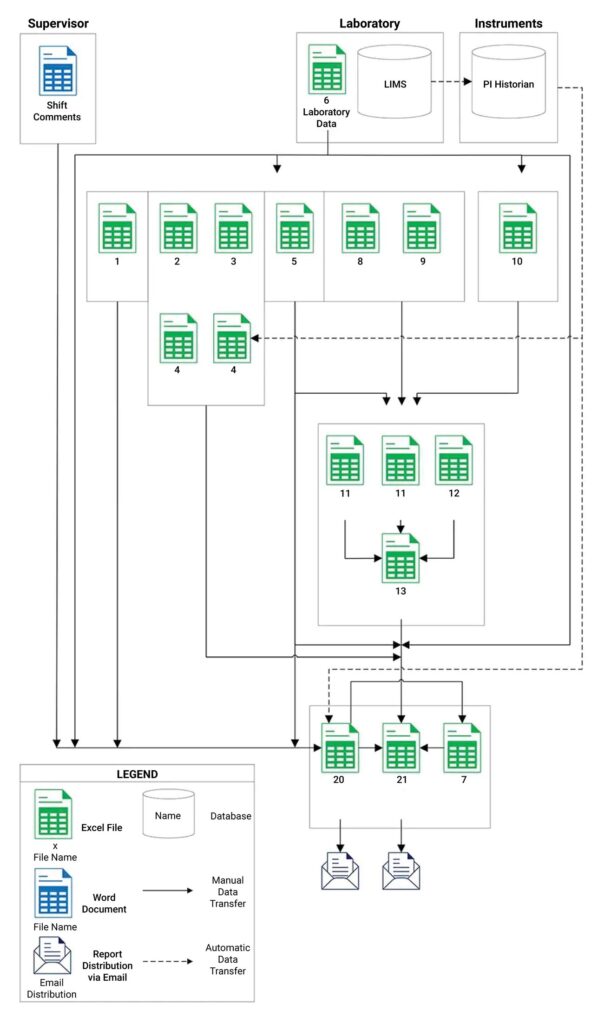
Below is the same site’s data flow diagram, however with an MI Core implementation. As can be seen, there is a very clear and structured flow of data from the source data systems, to MI Core, to reports that are distributed to the site. MI Core is integrated within the sites other management information systems, with a one-way transfer of data.
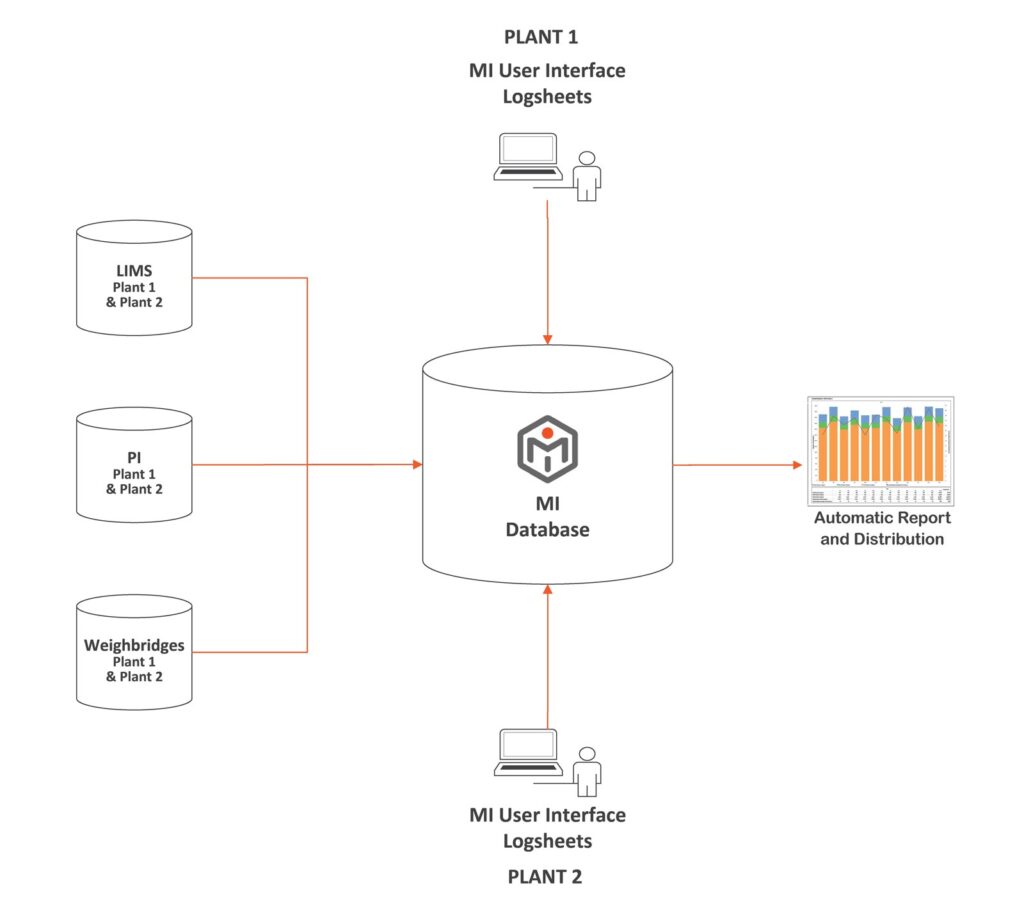
Principle 2 – The system must be consistent and transparent and the source of all input data to the system must be clear and understood by all users of the system. The design and specification of the system must incorporate the outcomes of a risk assessment of all aspects of the metal accounting process.
MI Core software provides complete data transparency. All data is extracted from source data systems automatically, without user interactions, as defined clearly within interface specification and system documentation. Any data that is manually inserted into the system is also tracked at a user level.
All system and user actions are recorded within the MI Core activity feed, which forms a permanent record within MI Core. Systems are deployed at site level, with an unlimited number of web-based control panel users, grouped into user defined role-based security groups. This significantly reduces the risk of users sharing accounts which would degrade system transparency and auditability.
MI Core also includes advanced features that allow users to monitor source data integrity. Any reloading, modifications, corrections, or comments to any datapoint is immediately and permanently logged within MI Core at the exact date, time and the personnel that made the alteration. As a result, any individual action or value can always be traced back precisely to the originating source.
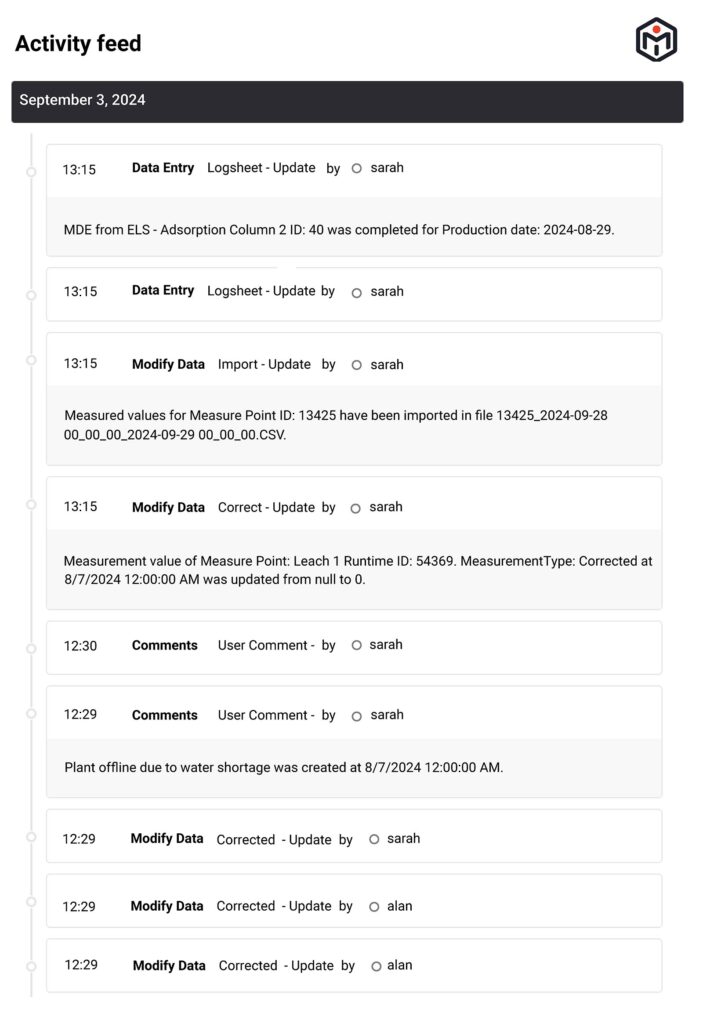
The incoming data can be easily understood, as data points are grouped into different datasets, such as from instruments or manually entered data. All data that comes in and out of MI Core have their own unique tag within their datasets so they can be identified and linked to the source easily. Each individual Measure Point has unique tags readily available and easy to access. Users can also clearly see the number of individual datapoints, and if any changes were made to unique tags.
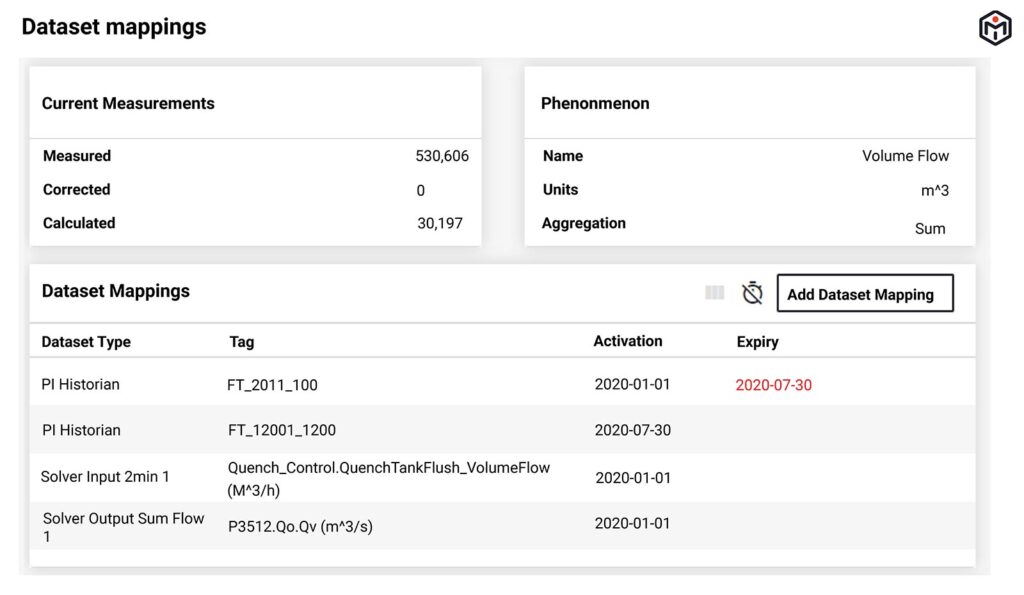
If required, users are also able to easily add data corrections and an associated comment. A record of this data correction, the user making the correction, and the original uncorrected value are all recorded.
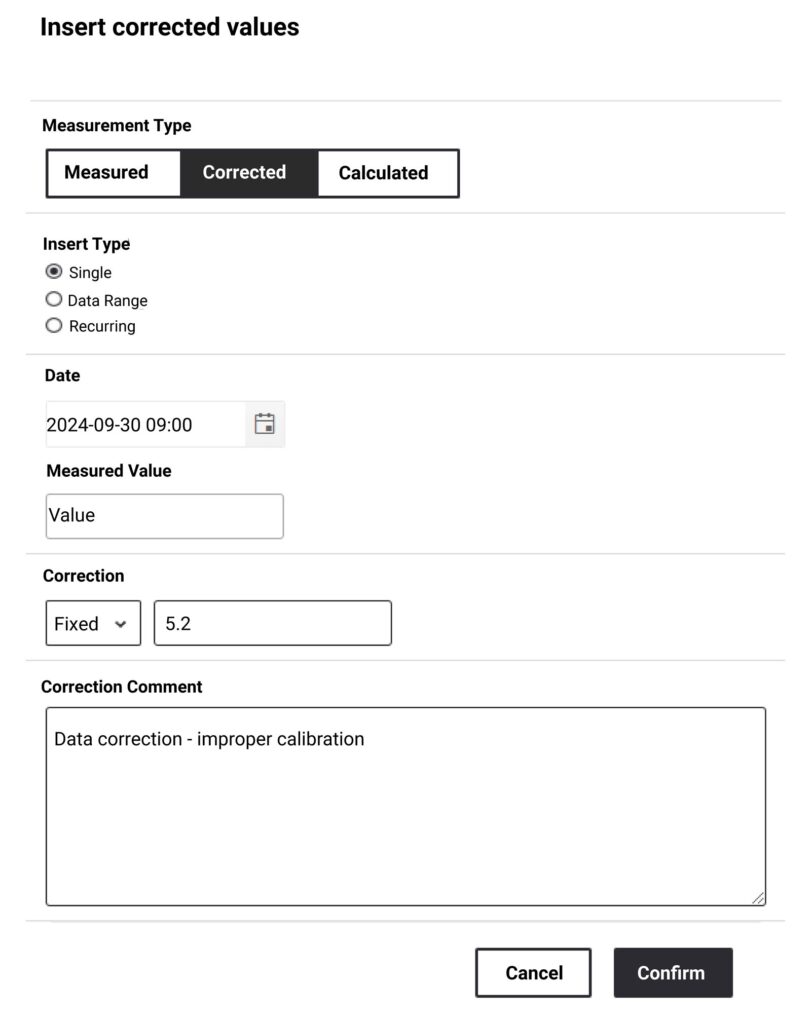
Principle 3 – The accounting procedures must be well documented and user friendly for easy application by plant personnel to avoid the system becoming dependent on one person, and must incorporate clear controls and audit trails. Calculation procedures must be in line with the requirements set out in this Code and consistent at all times with clear rules for handling the data.
The MI Core digital twin metal accounting model, based on mass balance principles, operates routinely and efficiently without any user intervention. Model flowsheets, logics & calculations are documented and made available within the MI Core system for all system users. Changes to calculations are tracked at model and Measure Point level to ensure complete transparency of all calculations and inputs. System configuration settings can be exported from the control panel at any time and reflects current and past solution configurations.
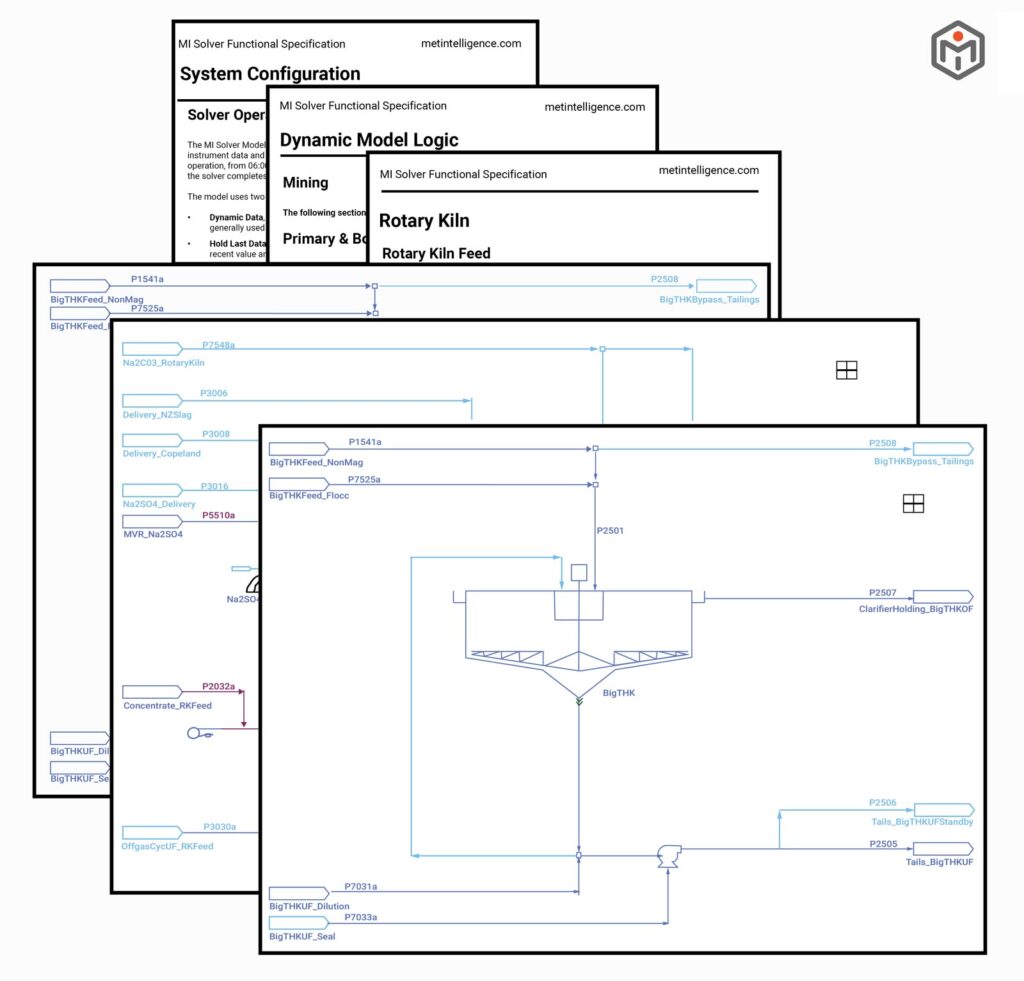
In person training from our experienced metallurgical accounting subject matter experts is available along with access to our comprehensive online training materials. Our online learning management system enables users to complete new modules or revise previous modules in their own time. Learning and development teams can also track every user’s progress against defined learning outcomes.
Clear controls and audit trails are in place through the activity log but also through the reports and approvals system in MI Core. Reports are generated daily and can be approved by different levels, i.e., Metallurgist, Superintendent, Manager. The specific user who completed the approvals as well as the date time is recorded and the next user in the hierarchy can be notified via email or control panel that their approval is required.
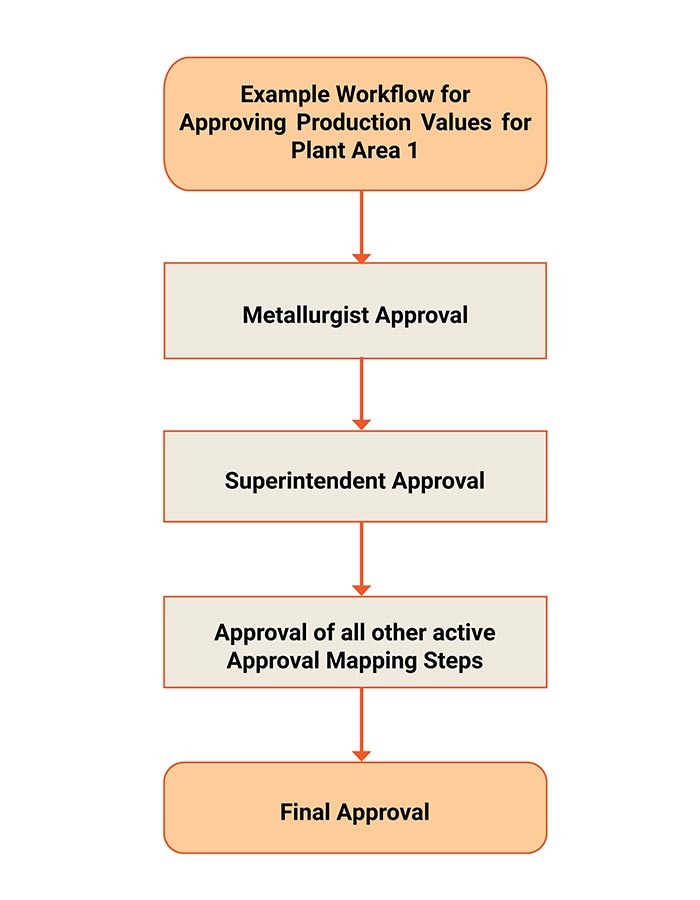
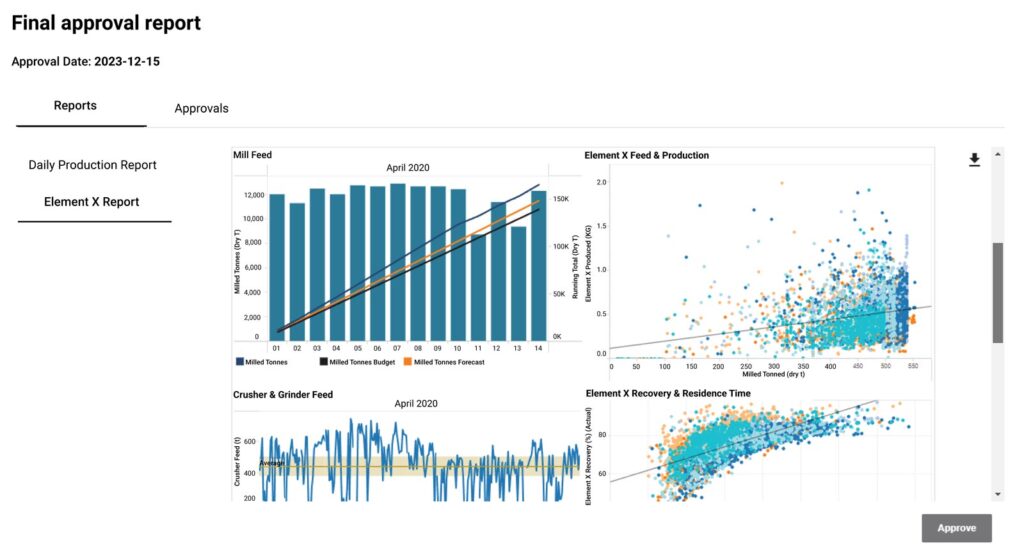
To ensure that the accounting procedures are user friendly for easy application by plant personnel, each user has access to a large array of training courses which cover all aspects of the system. Our Learning Management System (LMS) is tailored to each user so they will have access to the appropriate courses. Specific roles and access to MI Core is only allowed once the users have completed the required prerequisite courses in the LMS.

Principle 4 – The system must be subject to regular internal and external audits and reviews as specified in the relevant sections of the Code to ensure compliance with all aspects of the defined procedures. These reviews must include assessments of the associated risks and recommendations for their mitigation when the agreed risk is exceeded.
The MI Core digital twin model is regularly reviewed by both site personnel and Metallurgical Systems engineers to ensure system alignment, and to ensure all identified risks are monitored. Audits can occur at any point in time, and auditors can access the system independently once the dedicated online training course is completed. All work procedures and any other relevant information can also be made available through the solution control panel, centralising all relevant information for auditors and users alike.
Auditors typically focus on calendar month results. Analysis of these results, at a monthly level of detail, limits the visibility of plant performance, and degrades risk identification processes. MI Core is the only metallurgical accounting solution that enables auditors to review data at any level of detail. Every monthly result can be drilled down to individual hourly values, which provides the auditor unparalleled transparency of plant performance with the ability to overlay any user comments, to ensure all controls that form the governance framework are easily monitored.
MI Core’s advanced reporting capabilities allow users to create dashboards to monitor risks identified as part of the audit process that forms part of their daily routine.
Metallurgical Systems’ support team track all user support requests, including all correspondence which is available to audit teams. Detailed support reports are provided to site with breakdowns based on the requested interval to meet site business requirements.
During each MI Core feasibility study, the site metal accounting system is reviewed and audited. Assessments are made on the process and suggestions given on improvements to sampling and instrumentation. Metallurgical systems also performs reviews/audits regularly at the request of clients after deployment. Each request item is tracked and documented in the support management system.
As part of the reconciliation routine, process alignment dashboards are created to compare the measured and reconciled values. These dashboards can be made accessible to auditors allowing the review to be done efficiently. Within these dashboards, users are able to drill down to the hourly level providing extra granularity and context. Corrections made to the data are also displayed in the dashboard, making it transparent where and what data alterations were made by site personnel.
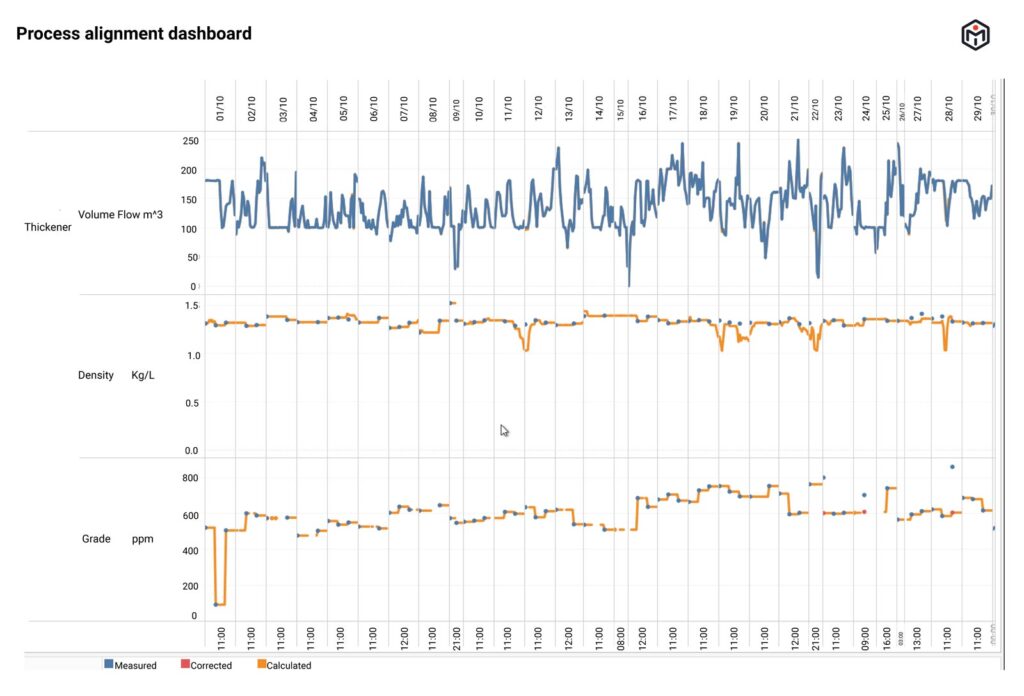
Principle 5 – Accounting results must be made available timeously, to meet operational reporting needs, including the provision of information for other management information systems, and to facilitate corrective action or investigation. A detailed report must be issued on each investigation, together with management’s response to rectify the problem. When completed, the plan and resulting action must be signed-off by the Competent Person.
MI Core extracts data from a multitude of plant sources automatically and without user intervention, based on the required time interval. Typically this occurs daily, but in some cases can be every shift or hourly. Data extraction across multiple systems occurs concurrently and in parallel, ensuring data is loaded in seconds. Once the data loads, the digital twin dynamic model is automatically loaded, and all calculations are carried out. Once calculations are complete, all linked reports can be sent to customised distribution lists, ensuring all relevant data is sent to those who need it in minutes, without any dependency on users. Legacy metal accounting solutions based on desktop applications should not be considered compliant with this principle, as modern server-based technology enables unparalleled speed and efficiency.
The MI Core data warehouse enables users to generate any required report quickly and simply. The centralised and detailed data enables investigations into the plant to be performed quickly, without collecting and collating many different spreadsheets or connecting to numerous data sources.
Sign off and approval process are also built into the MI Core web control panel. This allows each site to configure their own sign off process, which can include internal and external reviewers, while ensuring all interactions and comments are captured.
For example, a daily production report such as the one presented below can be easily configured to be distributed on a regular basis to all relevant personnel. This report is configured to distribute once the dynamic model completes, which is scheduled to run after all data is loaded at the beginning of the day, meaning the report is available prior to production meetings to allow decisions regarding the plant to be made quickly based on accurate and recent data.

MI Core puts in place the framework for metallurgists to first review and subsequently approve production/monthly reports prior to distribution to the wider audience. The system keeps track of the provision of the information through the approvals system. The personnel in charge of approvals will be responsible for facilitating corrective action or investigation on a timely basis.

The corrections made in MI Core due to a corrective action or investigation must include a corresponding justifying comment. MI Core also records the specific user, date and time of the correction. This information is available in an automated report outlining all corrections that are made and their associated comments.
Principle 6 – Where provisional data has to be used to meet reporting deadlines, such as at month ends when analytical turn-around times could prevent the prompt issuing of the monthly report, clear procedures and levels of authorisation for the subsequent replacement of the provisional data with actual data must be defined. Where rogue data is detected, such as incorrect data transfer or identified malfunction of equipment, the procedures to be followed together with the levels of authorisation must be in place.
MI Core analyses the quality of data, and subsequent status of the results. The system automatically analyses source datasets to determine if the data for any given day meets the requirements to allow it to enter an approval process. Results that do not meet the requirements are flagged as interim with details on why it did not meet the requirements. To complete month end results in a timely manner, MI Core allows users to validate inventories and results at any time during the month. This allows for progressive approval, reducing the workload of metallurgical accounting teams at month end.
The MI Core daily routine also involves error checking and data quality analysis, and as a result issues with data inputs are typically identified immediately and can be managed as required. All corrections are tracked in the application activity feed, with user comments linked to actual results. This streamlines the metallurgical accounting review and approvals.
MI Core also has a robust data approval system with respect not only to data entered manually into the system, but also on the entire suite of data for a specific period. Only once a day’s data has been extracted with a completed model run can that day be approved by authorised personnel once the results have been reviewed.
Below is an example of a Data Quality page, which can be used to effectively identify sources of biases and errors within the plant. The charts presented are generated daily using current production data, and provide a comparison between model-calculated and site-measured values. As seen below, the site has been regularly able to ensure alignment at the FAG Mill Ore Feed Conveyor instrument (left chart), indicating good data quality. Additionally, there is a high alignment within the plant for Sulphur grades (centre chart), indicating assay sampling and laboratory techniques are suitable. However, the Primary Magnetic Separator (right chart) show a clear deviation between measured and calculated results, with a significant and inconsistent bias, indicating there are likely sampling issues onsite that should be investigated promptly.
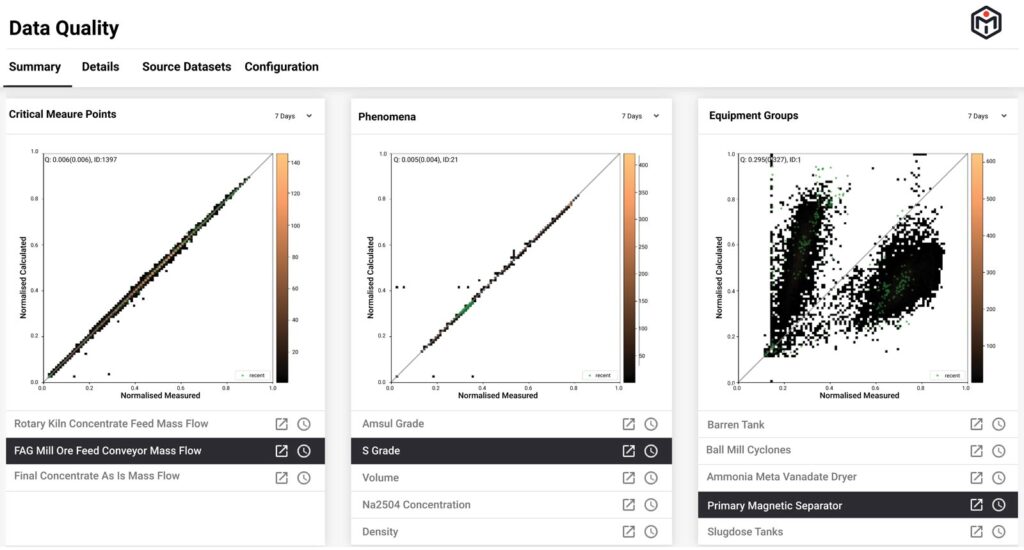
Principle 7 – The system must generate sufficient data to allow for data verification, the handling of metal/commodity transfers, the reconciliation of metal/commodity balances, and the measurement of accuracies and error detection, which should not show any consistent bias. Measurement and computational procedures must be free of a defined critical level of bias.
The MI Core digital twin is a dynamic model that centralises all available plant, laboratory, product movement and other manual data as inputs. Following this, for every minute of every day, the dynamic model will calculate the mass balance of all streams and inventories – including intermediate streams and inventories – for the entire plant. The calculation also captures the state of each equipment item. The results are then aggregated to an hourly level, to allow for reporting of all units and streams within the dynamic model. All key species are calculated, including chemistry, and this also extends to water, reagents, and other utilities.
Once the calculations have been completed, users are able to report on and verify individual model calculation results. The MI Core Data Quality module, in addition to this, allows users to not only to compare model calculation results to plant values, but identify consistent sources of discrepancy between the two at individual data point, phenomena or whole equipment group levels. This allows users to verify instrument and laboratory data routinely, and identify any biases that may be occurring on specific instruments, sampling within an area, or lab analysis methods. This feature is unique to MI Core, and other systems do not allow for this detailed level of verification.
One site at which MI Core was successfully deployed had a complex hydrometallurgical process that often could not reconcile leached assay results with the incoming and outgoing metal content. As a part of the MI Core digital twin implementation, the leach process was modelled to a high level of detail allowing for an understanding of metal transfers within the process that accounted for chemical engineering principles such as residence times and reaction chemistry. Through the use of the digital twin incorporating metal transfers throughout the process, the discrepancies between assays at the site were able to be identified and realigned. Corrections made to the raw data are captured with comments on why the alteration was made.
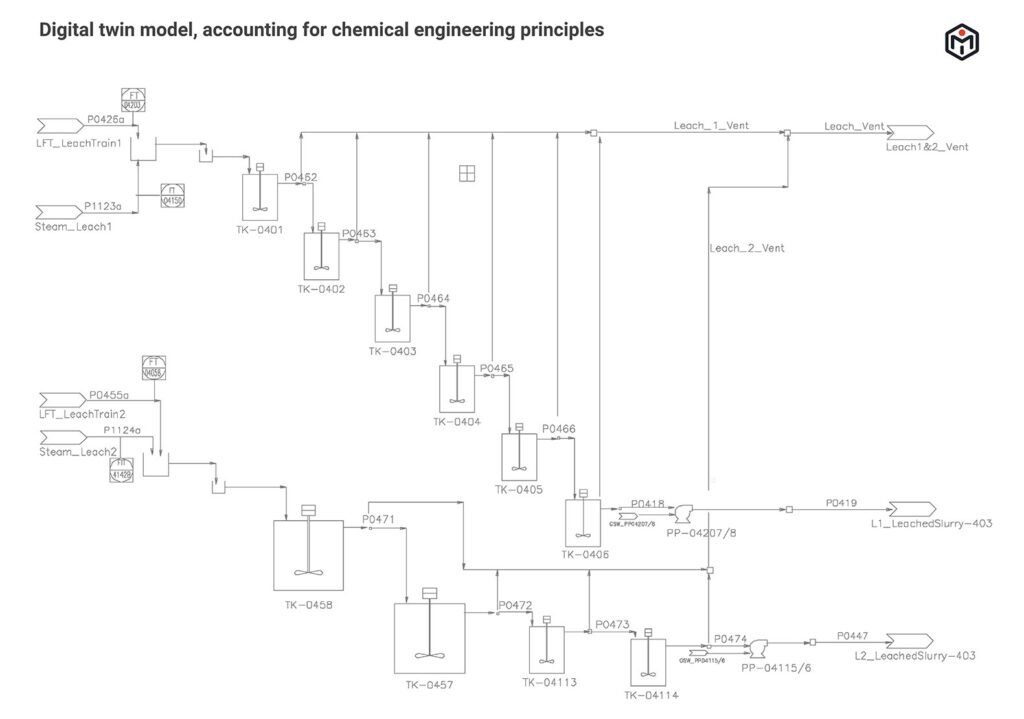
As seen below, whilst the leach feed grade is aligned between the site (blue) and model calculations (red), the leach grade and concentration discharges do not always align. The leach discharge grade often aligns, with users being able to enter manual corrections (orange) after discovering a discrepancy. The leach discharge concentration samples were discovered to be inaccurate, and so model interim calculation (green) assays can be used to inform the site metallurgists on what the actual assays should be. These predictions are then used to apply corrections to the measured results to allow for a more accurate final assay.
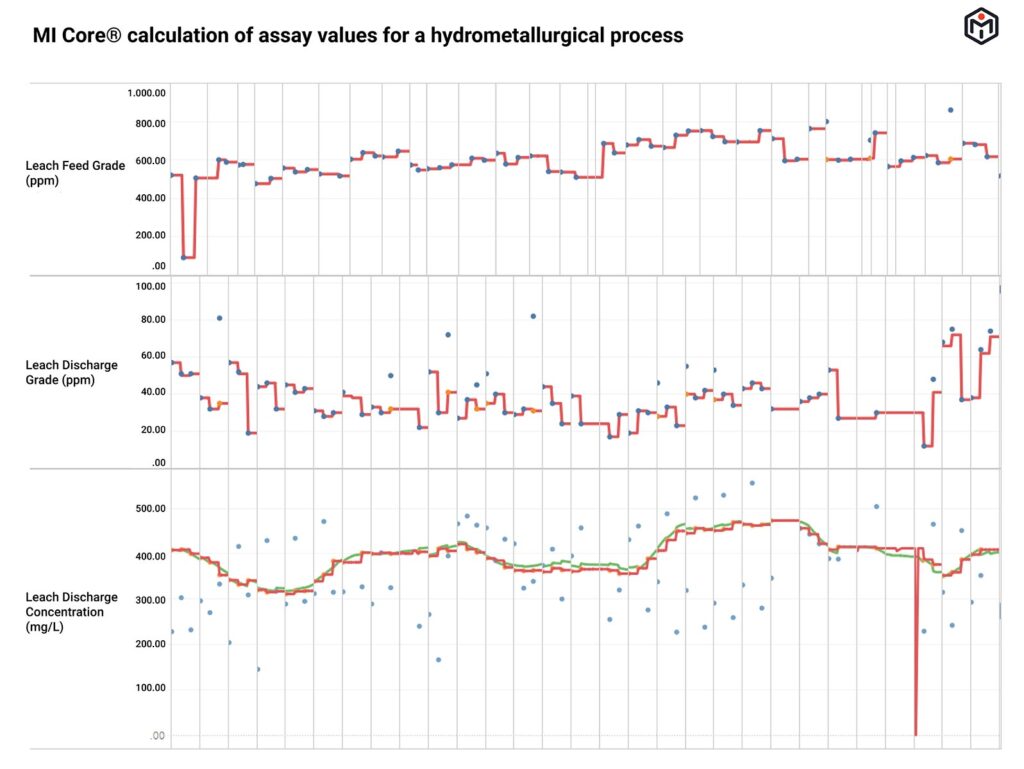
Principle 8 – Target accuracies for the mass measurements and the sampling and analyses must be identified for each input and output stream used for accounting purposes. The actual accuracies for metal recoveries, based on the actual accuracies, as determined by statistical analysis of the raw data, achieved over a company’s reporting period must be stated in the report to the Company’s Audit Committee. Should these show a bias that the Company considers material to its results, the fact must be reported to shareholders.
The transparency of the MI Core digital twin model, in terms of how all calculations are conducted and the individual data inputs, allow for a clear understanding of the results. Raw data is subjected to the data quality analysis which includes statistical analysis and identification and tracking of accuracies. In addition, due to the functionality of the digital twin model to cross-check its own calculations and inputs via a numerical mass balance, the accuracy of the individual inputs can be verified. This makes it possible to determine if a result’s accuracy is statistically relevant, or in fact due to a change in the process. All data is available for inclusion in company reports.
One site that had MI Core deployed had consistent issues with the accuracy of their mill feed conveyor. Despite it being a key stream in terms of determining the metal balance, the site was not able to accurately determine the correct throughput prior to the installation of MI Core. Through the use of the digital twin, however, the mill feed rate was able to be calculated using a combination of other data throughout the plant, and a comparison of the instrument (blue) and model calculated (red) results was generated, presented below. Through this, the accuracy of the faulty instrument could be determined and understood.

Through MI Core and the digital twin, accuracies of measured values can be quickly and efficiently reviewed through the use of the reporting database. As seen below, plant-measured values (blue) have been analysed in terms of moving average (grey) with standard deviation bands included. An understanding of the error within the sampling and analysis method can thus be achieved.
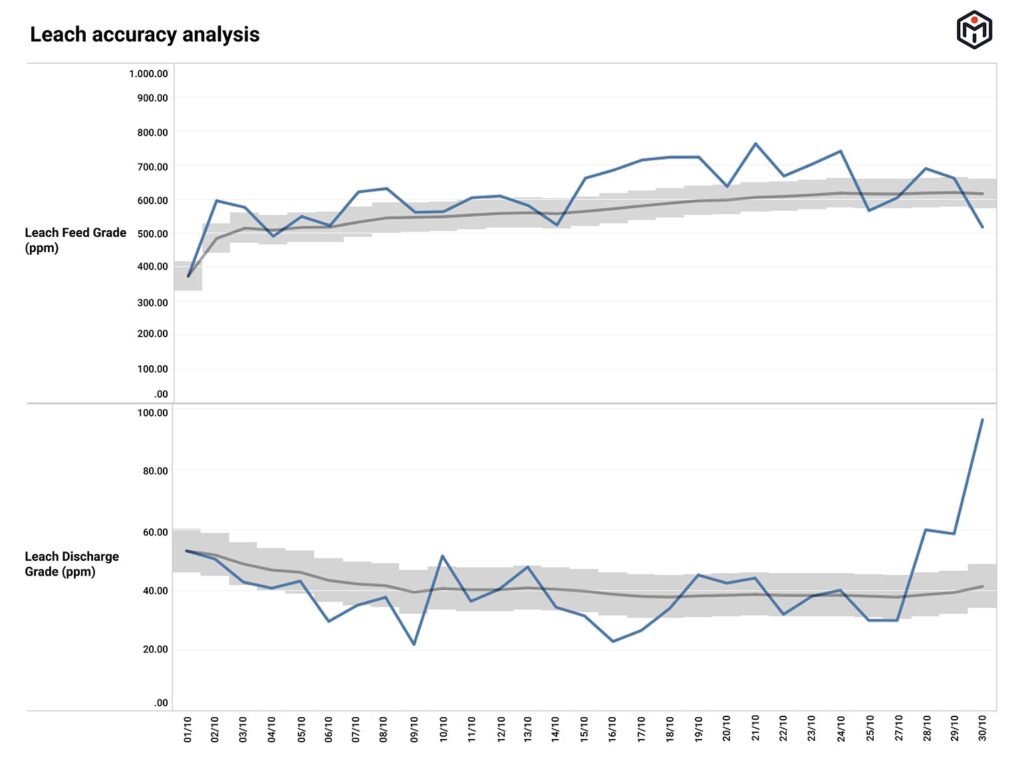
Principle 9 – In-process inventory figures must be verified by physical stocktakes at prescribed intervals, at least annually, and procedures and authority levels for stock adjustments and the treatment of unaccounted losses or gains must be clearly defined.
The MI Core process digital twin tracks all inputs, outputs and inventories at an equipment level across the entire process. This includes tanks, ponds, and stockpiles, where users can select different inventory calculation methodologies.
Calculation of in-process inventories on an hourly basis is unique to MI Core and allows operations to comprehensively exceed the requirements of the Amira P754 code. This capability represents a level of inventory tracking precision that wasn’t conceivable when the code was written in 2004/2005. No other software has this capability or feature.
Consider the example, when physical stock takes occur. Inventories will be checked throughout the course of a day rather than all at a defined end of day or at the same hour (in other words, at a single point in time). Legacy metal accounting systems are not able to consider inventories within a day, and as a result, these systems assign closing inventories to an arbitrary end of the day, rather than at the actual time of verification. This introduces significant discrepancies in legacy systems which are then incorrectly treated as errors.
Inventories can change rapidly throughout the course of a day, particularly at month end. Therefore without detailed inventory calculation the risk of double counting or miscounting process inventory is high.
Using MI Core, stock verification is assigned to the correct date and time, and if a valid discrepancy is identified, site personnel are then able to adjust or assign errors to inventory at the equipment level. All changes are also tracked in the solution activity feed to enable easy auditing.
The example below shows the contents of a concentrate thickener, over the course of a day. It clearly shows that a stock verification conducted in the morning and assigned to the end of the day would cause closing inventory to be overstated. Over the course of the two days, filtration rates were variable and thus the inventory fluctuated significantly.
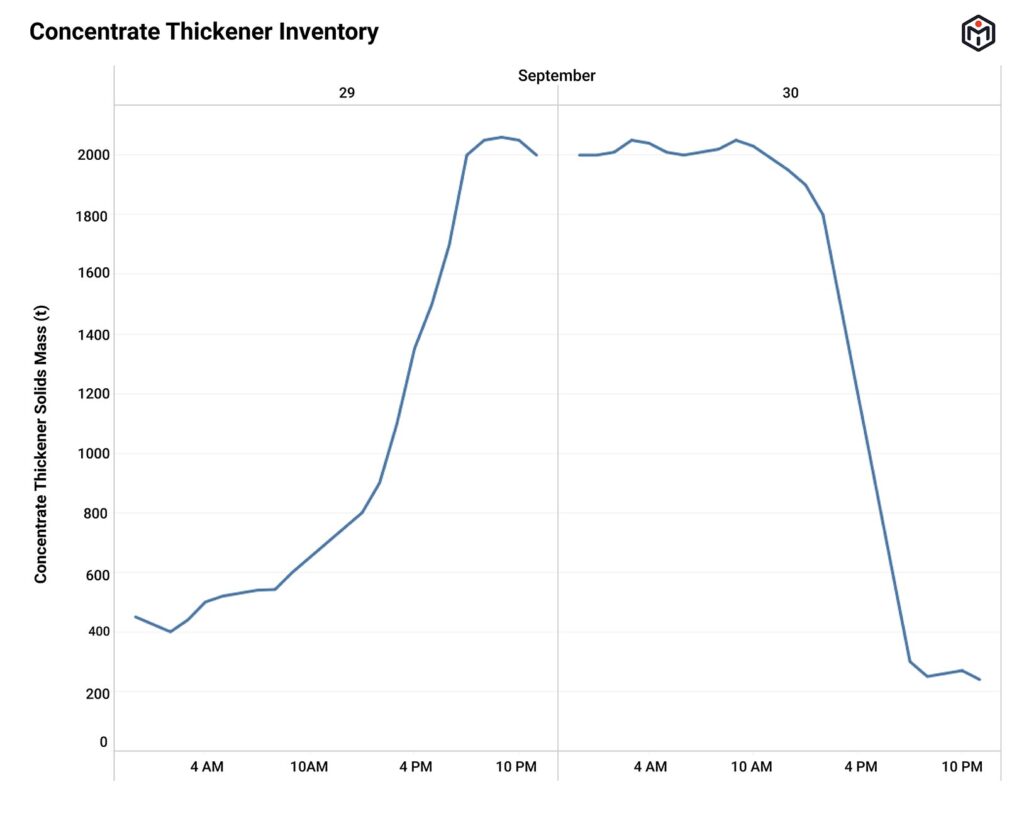
Principle 10 – The metal accounting system must ensure that every effort is made to identify any bias that may occur as rapidly as possible and eliminate or reduce to an acceptable level the source of bias from all measurement, sampling and analytical procedures when the source is identified.
The MI Core digital twin automatically identifies biases of instrument and assay data due to its nature as a dynamic mass balance that is consistently cross-checking inputs and calculation results within itself. The digital twin calculates the mass balance daily and reports each hour. Biases in input data are identified quickly to end users through the analysis of measured and calculated data. The deviation between the site-measured and model-calculated results are transparent and is the most effective way of identifying bias in a system that has changing inventory, changes in process conditions and residence time considerations.
In addition, MI Core contains an advanced Data Quality module that allows for daily review and identification of biases resulting from: individual datapoints, datapoints within a certain portion of the plant, or datapoints that are obtained through the same sampling or lab analysis method. This further empowers the site to identify and respond quickly to biases within the plant.
Any metallurgical accounting solution that does not utilise process digital twin technology cannot truly meet the requirement of Principle 10 in today’s context. While the AMIRA P754 code established essential standards in 2004/2005, modern technology has redefined what constitutes ‘every effort’ to identify bias. If a solution is not utilising current best practice technology like digital twin simulation and dynamic mass balance calculations, it cannot claim to be making every effort to identify and eliminate bias.
Biases can be easily identified in MI Core through review of the correlation between data points. In this example, the samples at seven different streams within a hydrometallurgical plant are compared to their model-calculated values to identify whether outliers are present in the source laboratory data. For the most part alignment between measured and calculated values are maintained, although some deviations occur, such as for a stream 7. This stream generally is biased towards higher model-calculated values compared to laboratory data, with the exception of a single value that sits far above the 1:1 relationship.
Further investigation into the circuit indicated that additional, unmetered water was being added into the circuit at stream 7 that the site was not aware of, and so was not captured in the digital twin. To identify if the single value was a genuine outlier, laboratory data for different streams on the day of, one day before, and one day after the single assay was taken can be compared. Further analysis showed that measured and calculated values aligned for all other streams at these times, which indicated that this value was an actual outlier.
Additionally, measured values are occasionally higher than calculated for streams 4 and 5. After further investigation, it was uncovered that there were issues with the recorded laboratory values, and overreading compared to results elsewhere in the plant as they could not be reconciled.
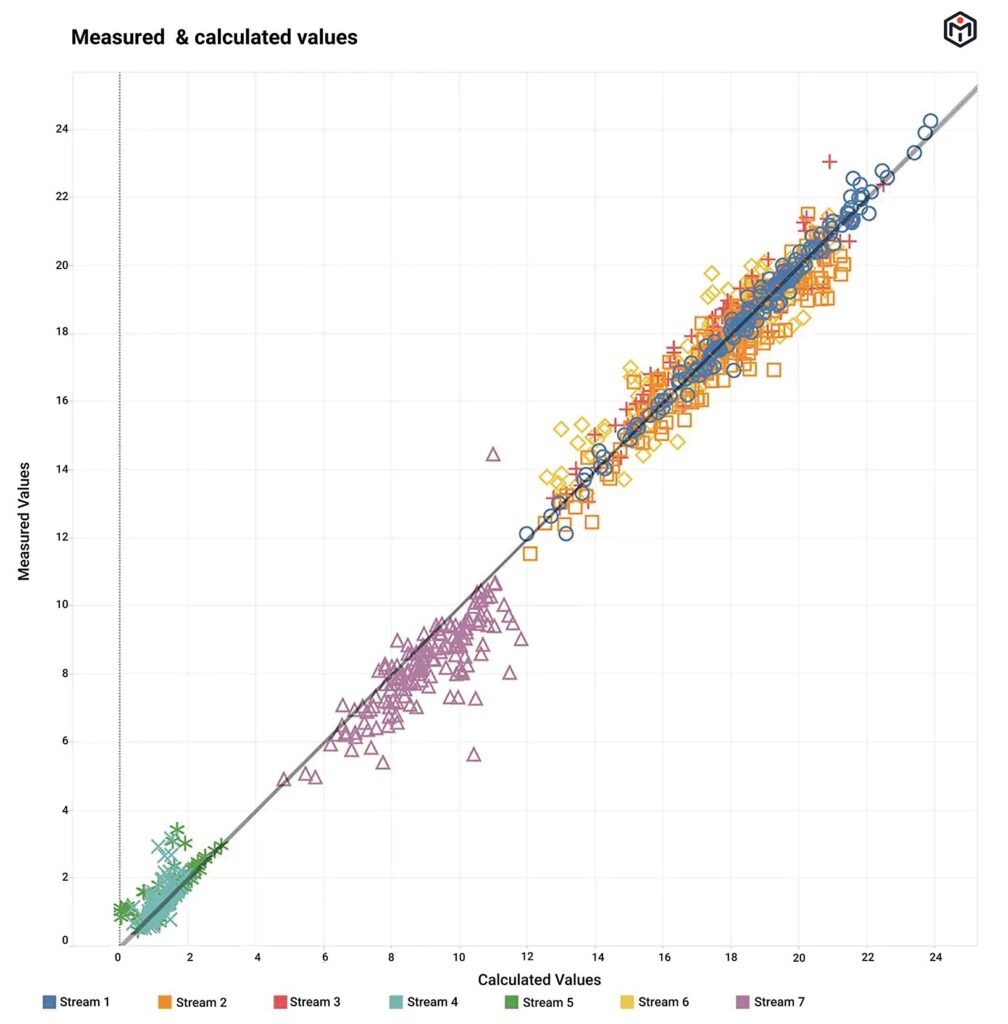
Beyond compliance: The business case for modern metal accounting
The business case for implementing modern metal accounting technology extends far beyond compliance. As proven in numerous case studies, MI Core implementations have helped mining and minerals operations recover millions in lost production through improved process efficiency and prevention of product losses.
As organisations face increasing pressure around sustainability reporting, MI Core’s validated, traceable activity data also enables both ESG framework compliance and informed climate transition planning. With new global sustainability legislation requiring detailed environmental impact reporting, having a single source of truth for operational data ensures accuracy in climate disclosures while streamlining reporting processes.
By implementing modern metal accounting technology like MI Core, organisations not only exceed AMIRA P754 requirements but also position themselves to meet future challenges around financial optimisation and sustainability reporting.
To learn how our modern metallurgical accounting solutions can be used to optimise operations, meet new mandatory finance-grade sustainability reporting regulations and accelerate digital transformation, contact our team of engineers, metallurgists and technology professionals at +61 2 7229 5646 or info@metallurgicalsystems.com
About the authors
This article has been collaboratively authored by the team at Metallurgical Systems, and fact-checked and authorised by Managing Director and industry specialist John Vagenas.





